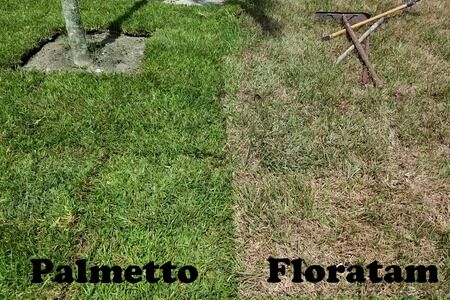Published: September 20, 2019, 12:09pm | Modified: September 6, 2020, 12:00pm
St. Augustine Palmetto sod is a leading warm-climate lawn grass that is a top choice for a wide variety of applications/uses. Not only is it suitable for homes and businesses, it is also a great option for recreational venues such as golf courses and parks.
When it comes to choosing the best type of sod for your lawn, it can seem like a daunting task. The look of the lawn of your home or business makes an immense statement. St. Augustine Palmetto sod allows you to have an ‘instant lawn’ that is not only aesthetically appealing but also ready-for-use much sooner than other methods such as seeding.
What is the Difference Between St. Augustine Grass and Palmetto Grass?
St. Augustine grass is a dark green grass with wide, flat blades. It forms a thick, almost carpet-like surface that is able to inhibit the growth of most weeds and other competing grasses. This type of grass does extremely well in warm climates and is commonly seen in environments where there is a fair amount of moisture such as shorelines, marches and lagoons. It is very versatile and does well in direct sunlight and also has a high shade tolerance when being compared to most other varieties. There are quite a few variations of St. Augustine grass, one of the most popular cultivars is Palmetto.
Palmetto is a variety of St. Augustine grass which offers a more vibrant lush, emerald green color and a finer texture than St. Augustine grass alone. This type of sod is a popular choice in coastal and subtropical regions, such as Loxahatchee Groves, FL.
Palmetto grass is known for deep, massive root systems which makes it the ideal choice for quick establishment and transplanting and can reduce the need for frequent watering. It enhances all of the positive qualities of St. Augustine grass and demonstrates exceptionally greater shade tolerance; in fact, it is able to flourish in just 5-6 hours of daily direct sunlight. This is one of the main reasons Palmetto grass was initially cultivated, when exposed to prolonged shade, the thickness of the sod only decreased minimally and remained a consistent vibrant color compared to other varieties. In addition, it is also drought tolerant and does well with cold temperatures and frost.
The Palmetto cultivar does best in cold temperatures we can experience in the winters here and has the ability to be least effected by frost. Another notable feature of St. Augustine Palmetto is its natural resistance to thatch buildup and chinch bugs, among other pests, when following proper maintenance guidelines.
Preparing Your Lawn for Sod
To prepare your lawn for sod you’ll want to start by removing any debris, stones, large limbs, etc. and to discard them. This is followed by removing and weeds, even by hand as needed will work. An important part of the process will be to turn the soil, use a mechanized tiller until loosened and aerated.
Next you’ll want to apply a starter fertilizer that is high in phosphorus and nitrogen, at approximately 10 pounds per 1,000 square feet. Next, add 1 inch of compost over the soils surface. After the compost is added, you will then need to till the starter fertilizer and compost to blend them together, till to a dept of 4 inches. Be sure to get your soil tested, beforehand.
St. Augustine Palmetto is relatively affordable type of sod. Please ask our professional team if you have any questions regarding pricing.
How to Maintain St. Augustine Grass
Proper lawn maintenance practices are a must to avoid issues or pests. Part of proper maintenance is good fertilization practices, this is key to a healthy lawn and can reduce vulnerability to insects, disease and stress. Before fertilization we recommend doing a soil test, the test will let you know the pH of the soil is and what the nutrient levels are.
There are 16 essential elements required for healthy lawn grass, the 3 major elements are phosphorus, nitrogen and potassium. There are 3 other nutrients that are required, but in smaller quantities than the three mentioned above; calcium, magnesium and sulfur. Once you get a soil test done you will know the exact proportions of each nutrient your lawn requires.
Most of the soil in Loxahatchee, and south Florida in general, has higher levels of phosphorus and lower levels of nitrogen. Optimal color and growth are typically achieved with a 70/30 ratio of soluble nitrogen and a slow-release fertilizer. A ratio of 3-1-2 (N-P-K) or nitrogen, phosphorus, potassium is a good overall fertilizer mix for St. Augustine Palmetto grass.
When fertilizing your lawn, it is very important to follow Florida-Friendly Landscaping™ Best Management Practices (FFL BMPs). Being familiar with these guidelines will allow you to not only maintain a healthy lawn but also lower potential pollution of water resources that can result from lawn and landscape fertilization and other practices.
How Often Should You Mow & Water St Augustine Palmetto Grass?
Moving along to watering and mowing your new/current sod. When your lawn is properly irrigated it allows it to develop a deep, healthy root system that will thwart off pests, diseases, and stress from drought. The amount of watering required will vary from season to season and be dependent on the weather, you will learn to use your best judgement. As a general rule of thumb here is our suggested guidelines for fresh sod are as follows:
- Apply water to the lawn in frequent but short watering sessions through out the day for five to ten minutes, do this for the first 7-10 day
- Apply water to the lawn once a day for the next 7 days, approximately ¼-1/2 inch
- At this point, you can reduce the frequency to 2-3 times per week, supplying the grass with 1/4 -1/2 inch per irrigation cycle
- Water as needed
The proper mowing height for St. Augustine Palmetto is 2.5 – 4 inches on average. Shady lawns can be mowed at about 3-4 inches. Higher temperature in the summer will require more frequent mowing then in the cooler months. Additionally, the lower you mow the lawn will increase frequency in which you will need to mow.
Ultimately, proper and consistent maintenance will ensure a healthier, more vibrant, emerald green lawn. Palmetto sod is a great choice for your South Florida lawn. It is one of the most popular and most requested sods we sell at One Stop. We hope we answered your questions on St. Augustine Palmetto sod. If you would like to learn more about other high-quality sod and turfgrass we have available, email or call us with your questions. We truly enjoy being a part of your landscape transformations and look forward to working with you to achieve your best lawn possible!

